2020 Triumph Street Triple RS Review
Motorcycle Test by Trevor Hedge
Images iKap / Triumph
Only two years after the last significant update Triumph have come out all guns blazing for 2020 with yet another major revamp of the Street Triple RS.
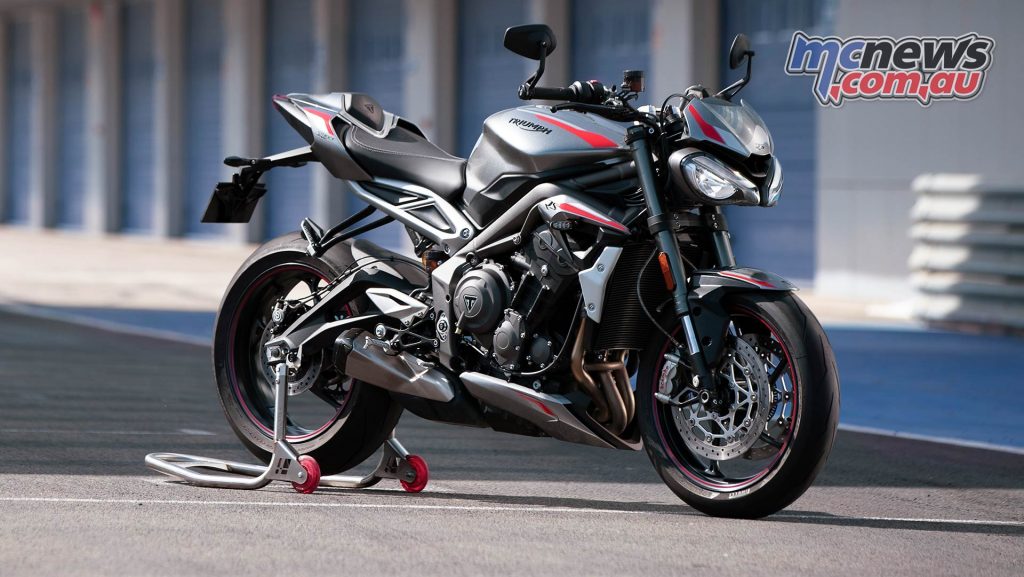
A major boost in performance came in 2017 that really pumped the sporting credentials of the Street Triple much higher than we had seen before, and pitched the model to a higher end market than previous generation Street Triple models. The Street Triple RS got its big boost from 675 to 765cc in that last update and now for 2020 that 765 cc engine has undergone major revisions to boast yet more performance.
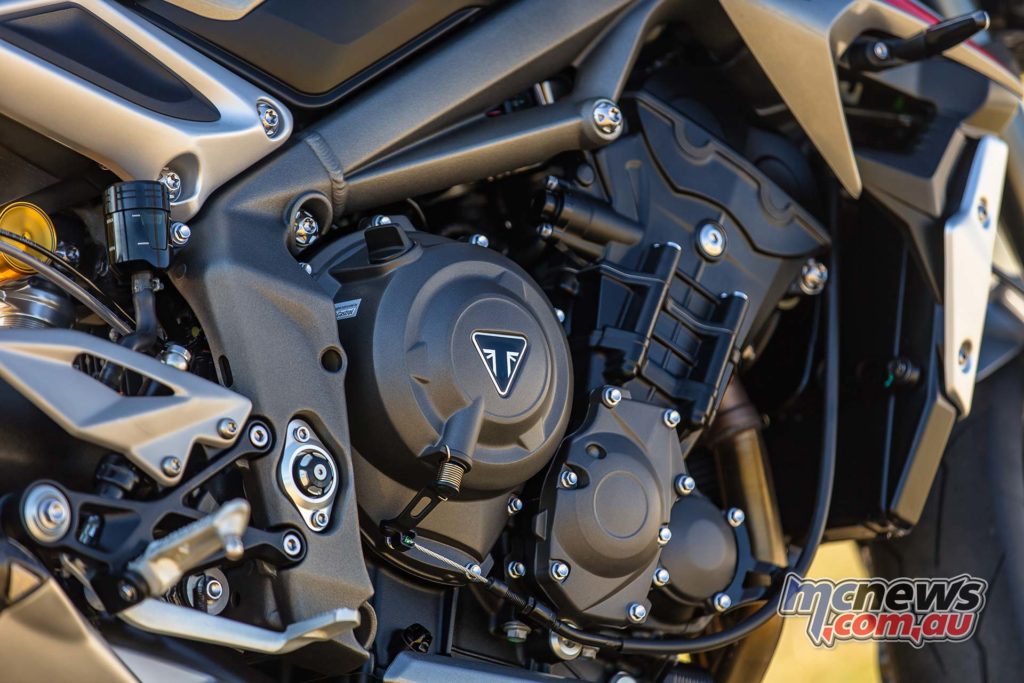
Better manufacturing tolerances within the gearbox have now negated the previous anti-lash gears on the balance shaft and the back of the clutch basket. Shorter first and second gears boost performance off the mark while Triumph’s now well proven slip-assist clutch reduces lever effort and aids positive lock-up on acceleration. An up-down quick-shifter continues the up-spec’ theme and works best when used in anger. When bumbling around town, the use of a little clutch helps smoothen things out.
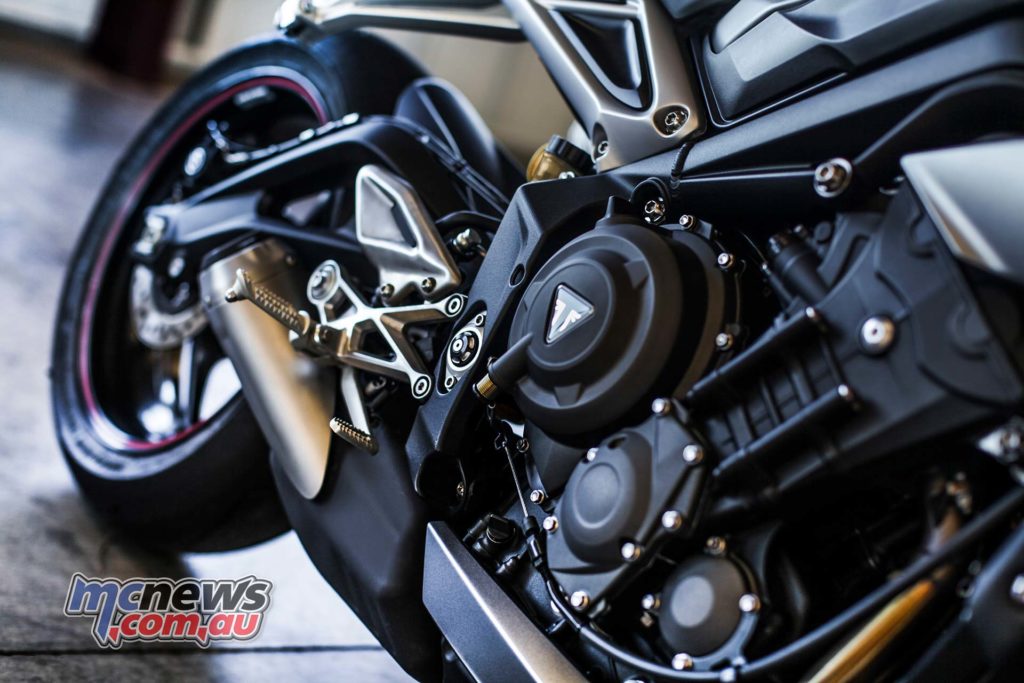
The challenge of meeting Euro5 specification has seen engine development programs across the whole spectrum of motorcycling step up a gear. Euro 5 has also seen Triumph install two smaller and more premium catalytic convertors that replace the previous single unit while a new balance pipe is claimed to smooth out the torque curve. The exhaust cam has changed while the intake ducting has also been revised.
So is this all about emissions and Euro5 or do we get more go?
That we do, and while peak numbers don’t change much, mid-range torque and power are up by a massive nine per cent.
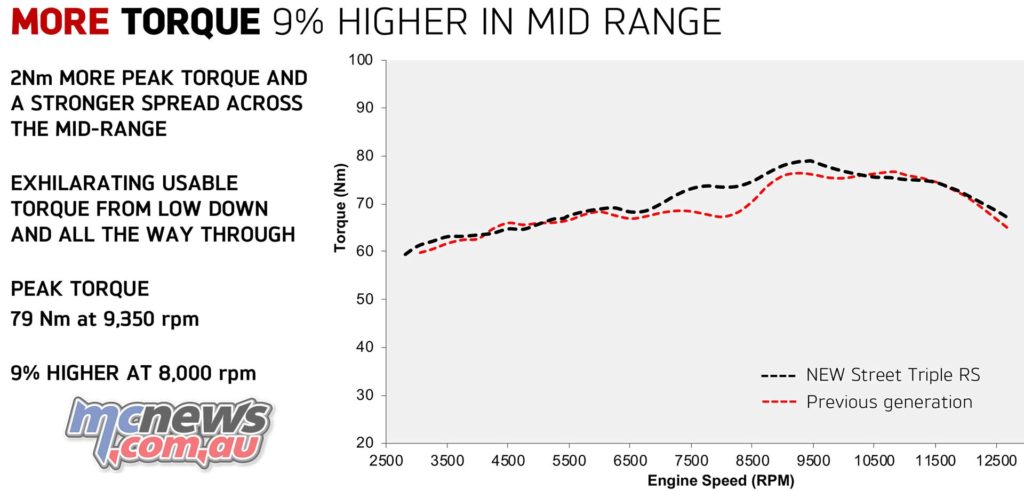
The 2020 Street Triple RS generates 121 horsepower at 11,750 rpm with 79 Nm of torque peaking at 9350 rpm. That peak torque is only 2 Nm higher than before, but between 7500 and 9500 rpm are where those much larger increases in torque are realised, and they are really felt on the road.
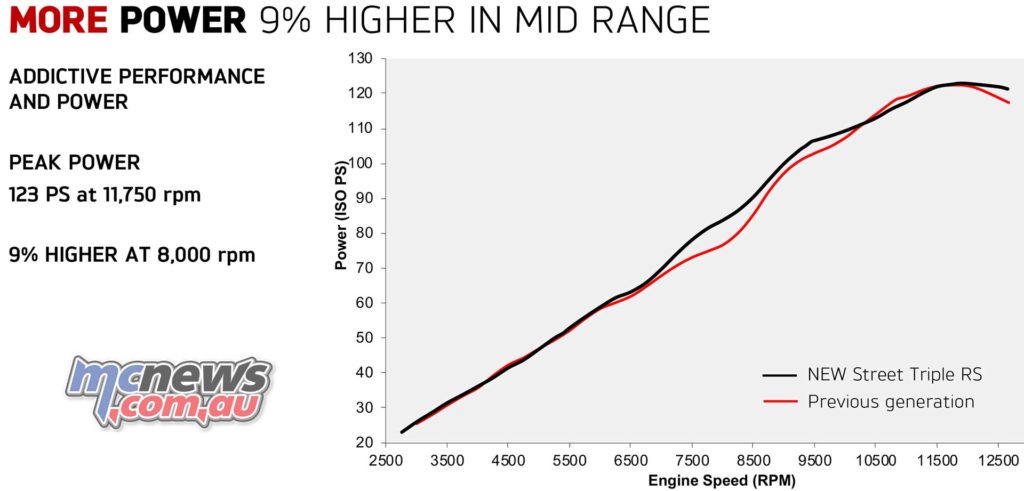
Engine inertia has also been reduced by 7 per cent due to improved manufacturing tolerances borne from Triumph’s involvement as the exclusive engine supplier to the Moto2 World Championship. Higher precision machining on the crankshaft and balance shaft are the primary contributors that help the motor to spin up much more eagerly than before.
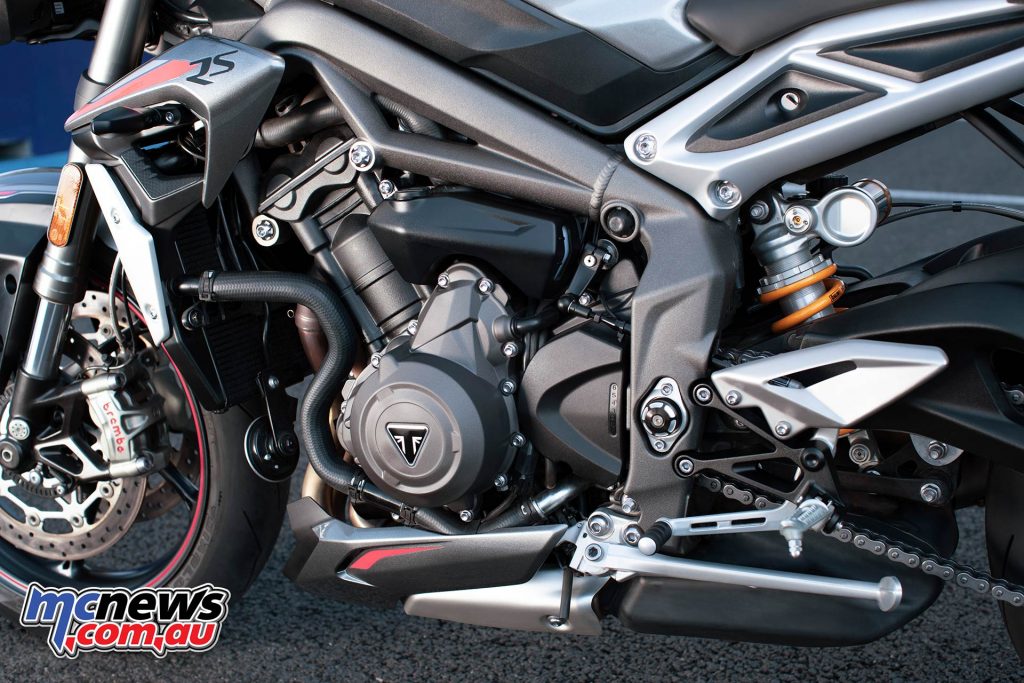
And it really does spin up so effortlessly that it actually takes you a little by surprise just how quickly the engine responds. This led me to staying out of the Sport mode for most riding duties as it was actually a little too frenetic. Even small road bumps that normally would never affect your throttle position were felt, such is the liveliness of this latest generation engine. The lack of inertia combined with the hefty increase in mid-range urge makes the new Street Triple RS feel a bit like an ADD kid fizzing to be let off the leash. General road duties are better undetaken in, funnily enough, Road mode, and the Track mode better left to the track… Triumph claim a seven per cent reduction in rotational inertia, it feels like even more.
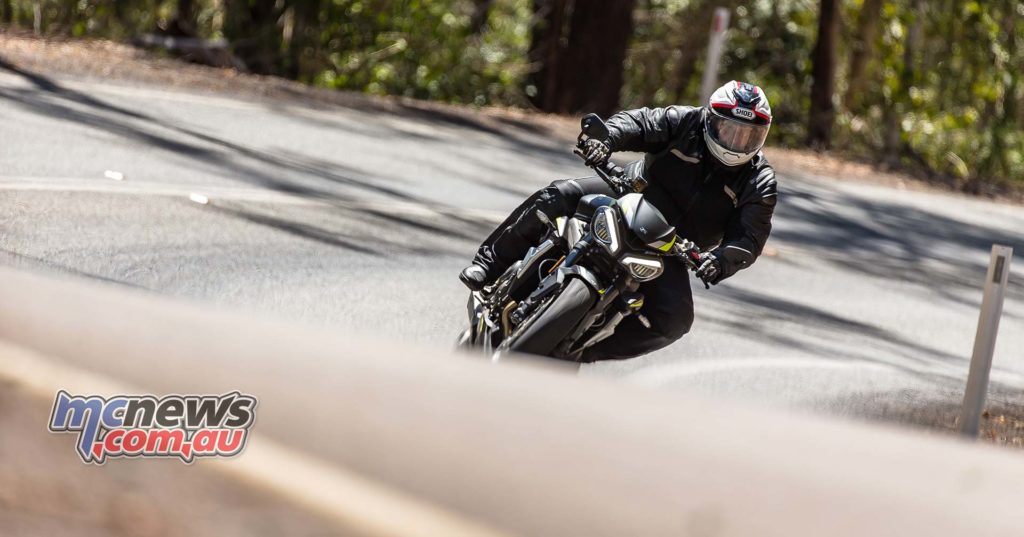
The original Street Triples of over a decade ago were very playful, and a doddle of a bike to lark about on while pulling monos all over the place or ripping skids. In contrast, these latest Generation Street Triple RS machines are much more serious, things happen much quicker and the outright level of sporting performance is a long way forward from the fun little street-bike that the Street Triple started life as back in 2007. While engine performance has come a long way, particularly in regards to the way it grunts out of the basement in to a very muscular mid-range, the chassis has taken perhaps even larger steps over that time.
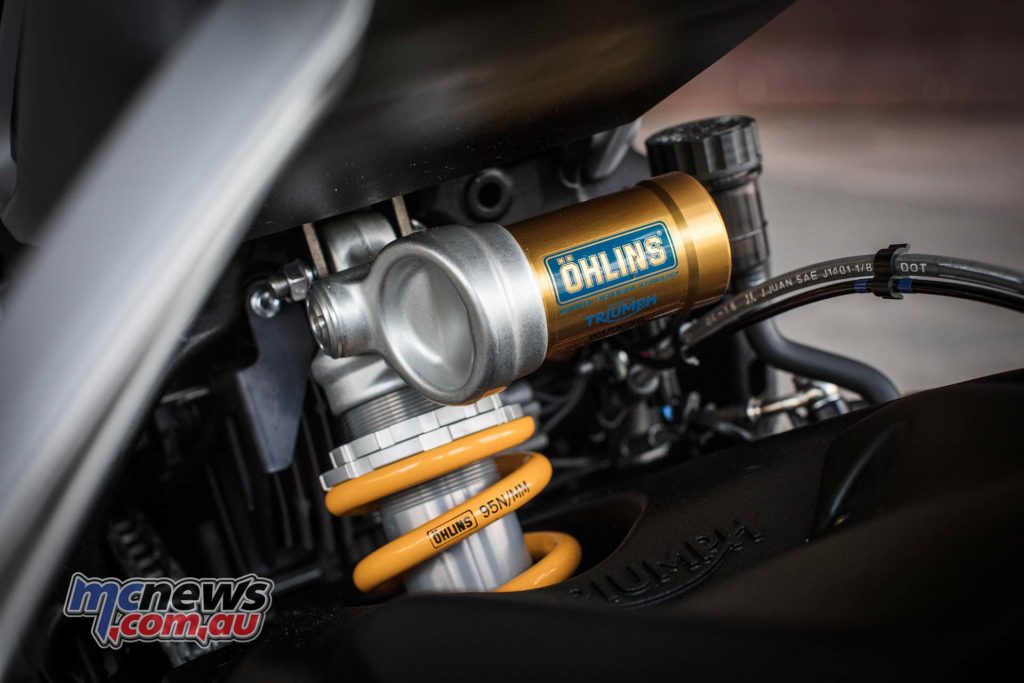
The RS model of 2017 is improved upon further for 2020 with an STX40 Ohlins shock replacing the TTX36 of the previous model. Triumph claim that it offers much better resistance to fade and runs at significantly cooler operating temperatures. The swing-arm is an interesting design with quite a radical gull-wing lay-out.
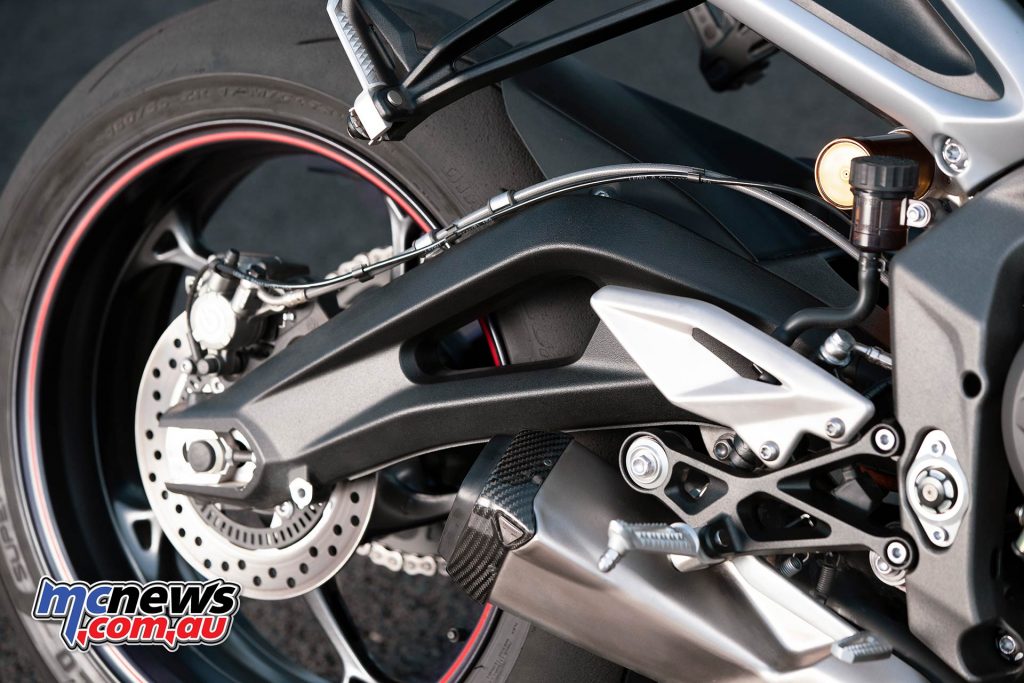
While I did not have the tools to measure the temperature of the shock I can attest that it remained fade free on bumpy Queensland back roads and also stood up to the rigours of Lakeside Raceway on a very hot December day. It feels like premium suspension should feel with quality damping response that provides great feedback to the rider, while remaining plush enough to not beat you to death on crap road surfaces.

Triumph chose 41 mm Showa big-piston forks for the front of the machine. Their engineers claim that this choice was made purely on performance as their test riders preferred the response of the Showa forks over the comparable spec’ Ohlins kits they evaluated. I found no reason to argue their findings after a busy few days on the bike. Adjusting the compression and rebound on the top of the fork legs is not as easy as I would have liked as they were obviously designed to use on a sports-bike with clip-ons, rather than with the single-piece bars on the Triumph that get in the way of the clickers.
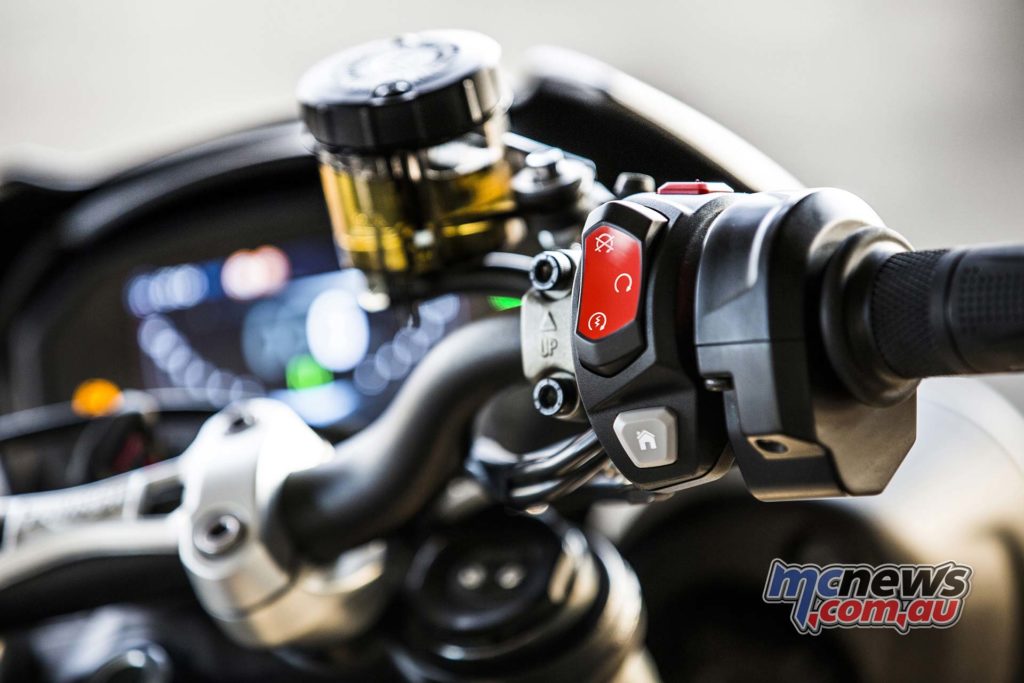
It is fair to say the kit at both ends is more than good enough in every role and you are going to have to be one very fast and accomplished rider before the suspension is going to be the limiting factor in your own performance. Most, myself included, run out of both talent and balls before the suspension is out of its comfort zone.
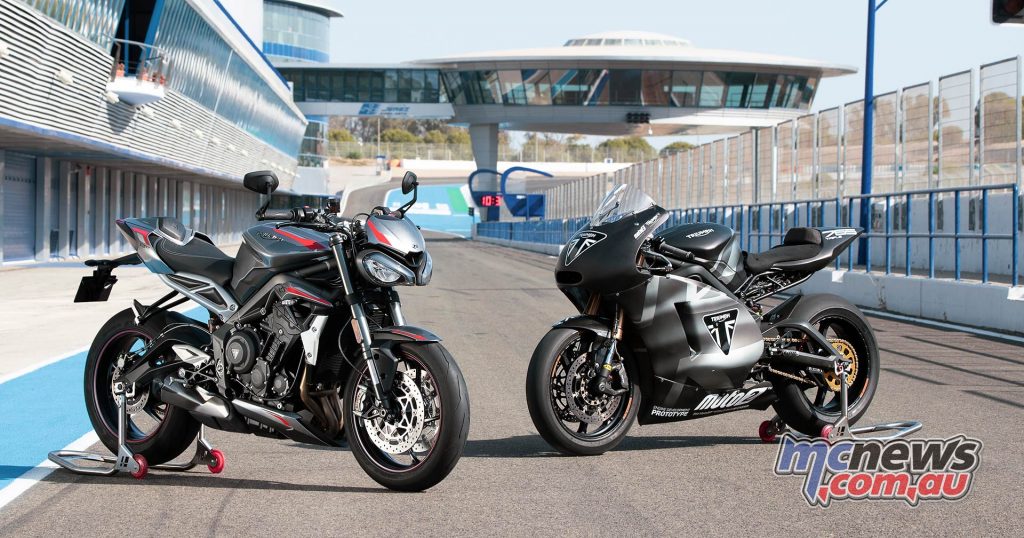
Still, I certainly don’t think that on a race-track it would prove quicker than Suzuki’s comparably out-dated GSX-R750. Despite its relative age the GSX-R is still quite a weapon of a sports-bike that is very easy to ride fast, thus it is actually somewhat of a testament to the naked Street Triple RS that its outright circuit performance can be even compared to the legendary GSX-R.
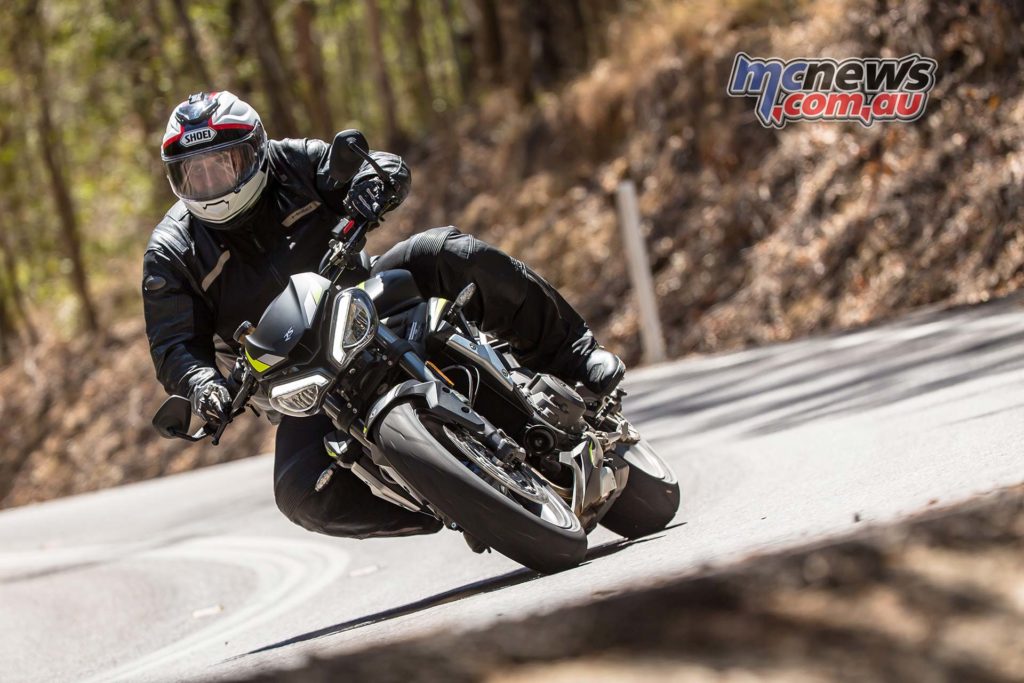
On a tight and testing back road though, the agility, mid-range punch and more upright stance of the Street Triple RS would win out and make for a more enjoyable back-road fang machine.
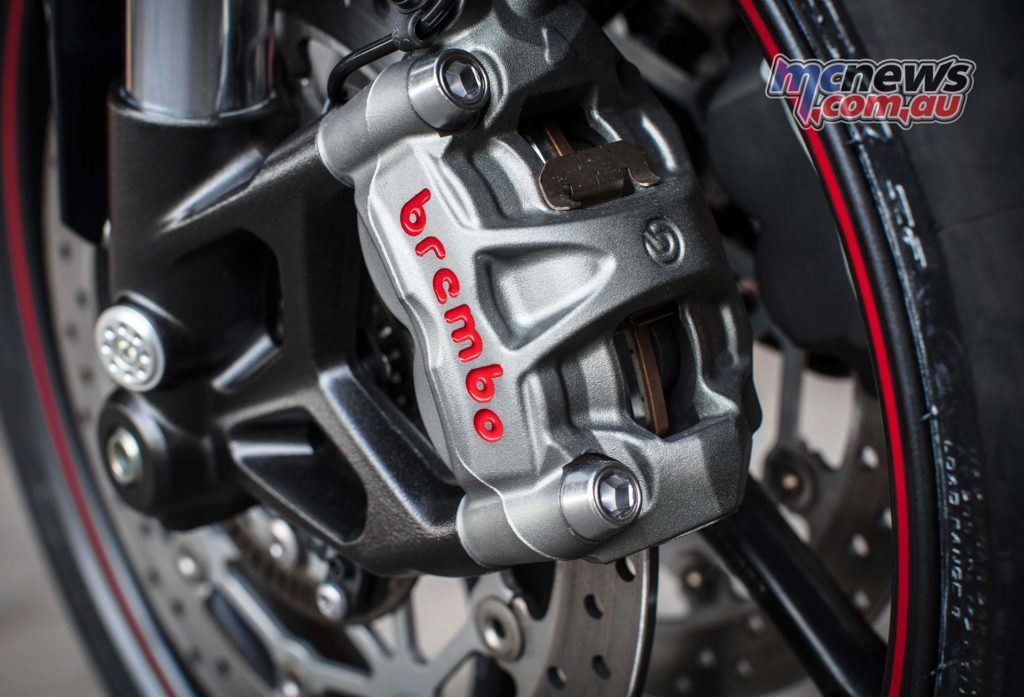
Brembo M50 four-piston radial stoppers complete with a Brembo MCS ratio and span adjustable brake lever were fault free in both power and response when hauling the 166 kilogram machine to a stop.
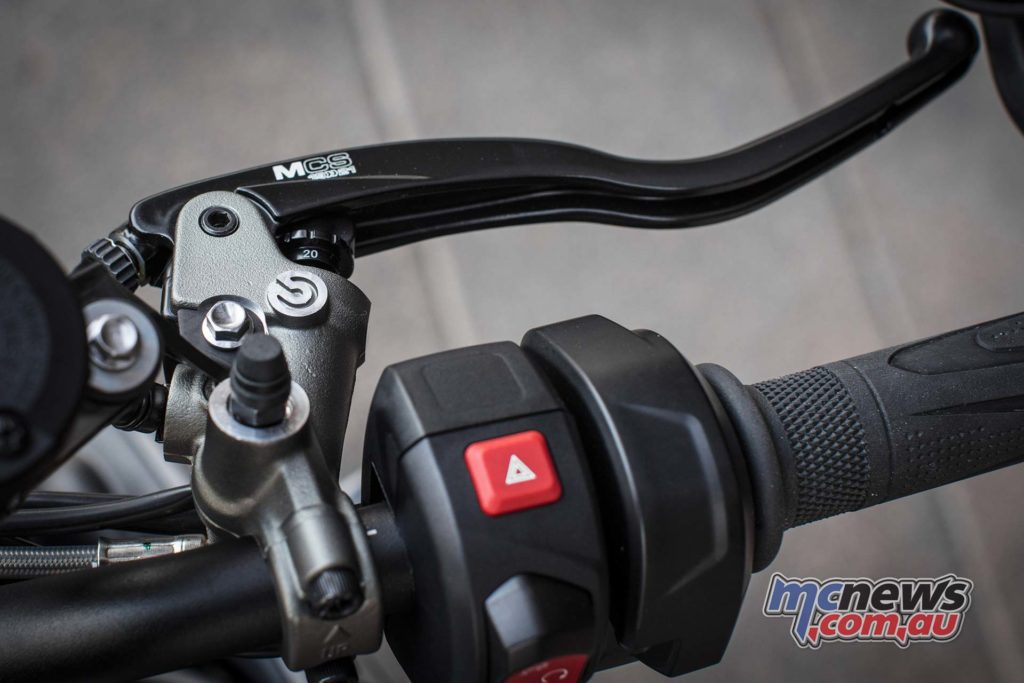
The bike actually feels even lighter than that 166 kg dry number as the first time I pulled it off the side-stand the bike banged straight into my legs as I had used way more effort than required. It feels more like leveraging a dirt-bike around than a regular road bike.
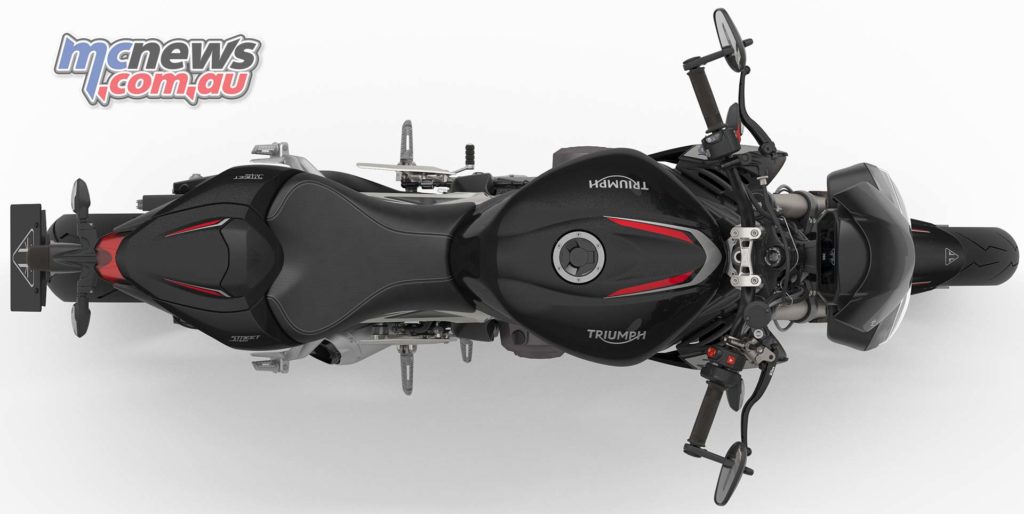
New LED headlights and daytime running lights sharpen the front end look and combine with a more angular silhouette all round that has further modernised the profile of the machine. Despite the minimalist proportions Triumph have managed to fit a 17.4-litre fuel tank in there which should make for an easy 300 kilometre touring range.
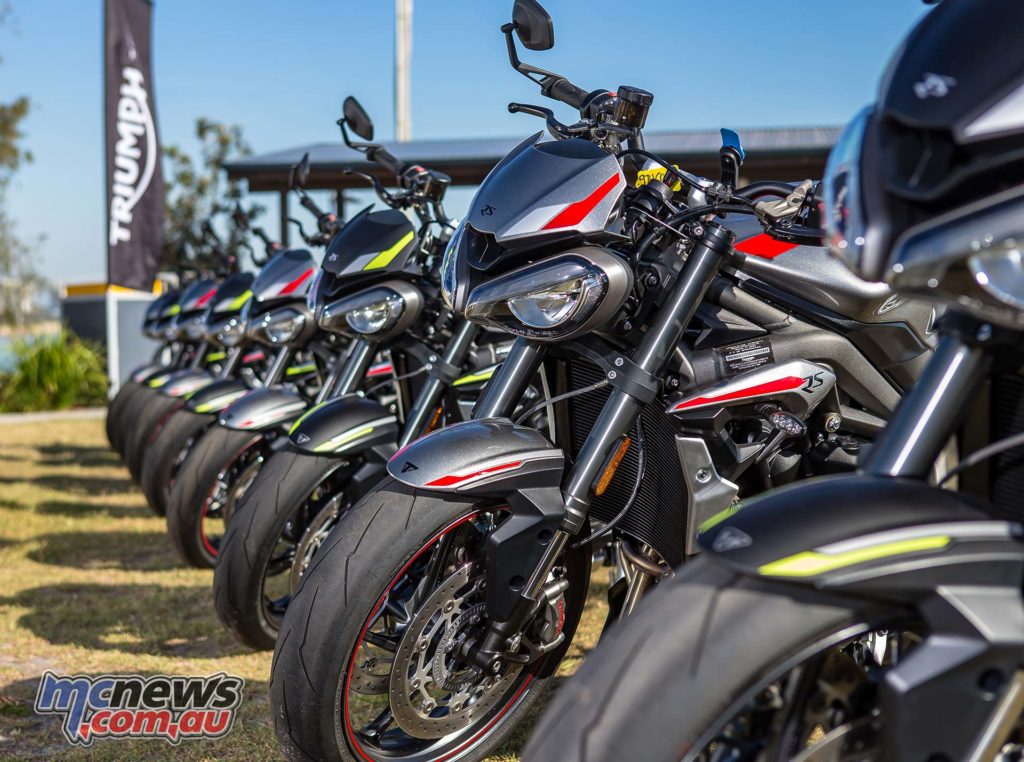
Instrumentation has gone full colour TFT and is available with GoPro and Bluetooth functionality to provide turn-by-turn navigation cues on the display via the optional connectivity module. The display can be switched through four different lay-outs and four different colour schemes.
Triumph have added some different layers of film in the display to greatly reduce glare but I found the default colour scheme not all that great in regards to the way each selection is highlighted when out in the sun and switching through the five riding modes or ABS/Traction settings. On the plus side the whole dash is adjustable for angle.
The navigation prompts and Bluetooth system with phone/music interoperability was still in the final stages of development and not yet available for us to test during the model launch but we are told the system is now fully functional and available for activation.
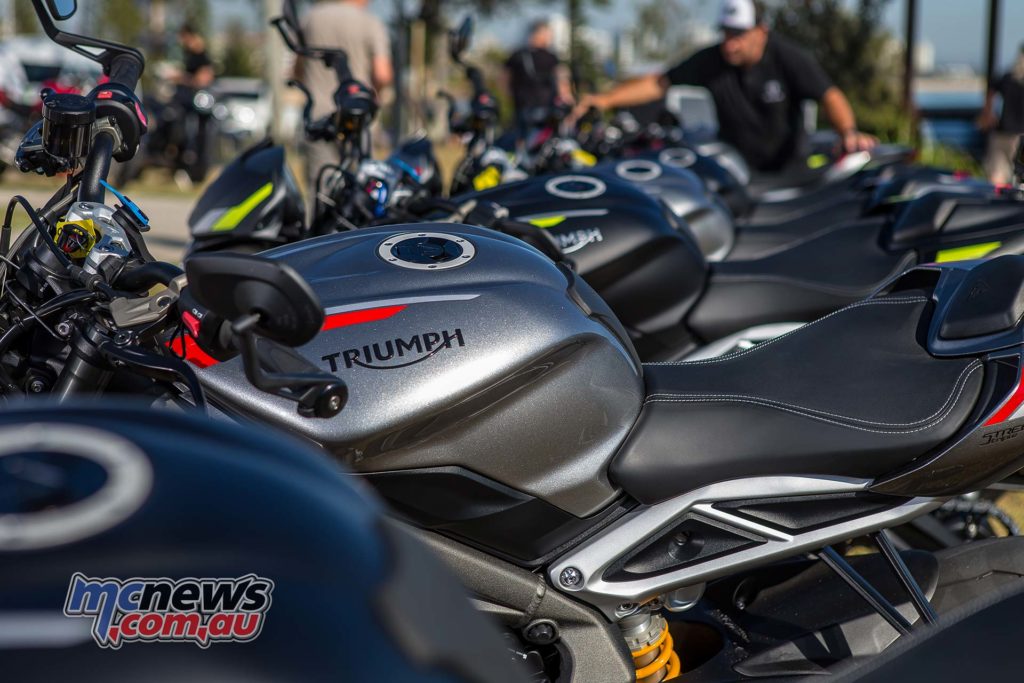
A new seat design and padding makes the perch an appreciably nicer place to spend time and at 825 mm is low enough for just about anyone. Triumph claim that the pillion seat is also more comfortable and boasts more leg-room but to me it still looks a horrendous place to contemplate spending any time.
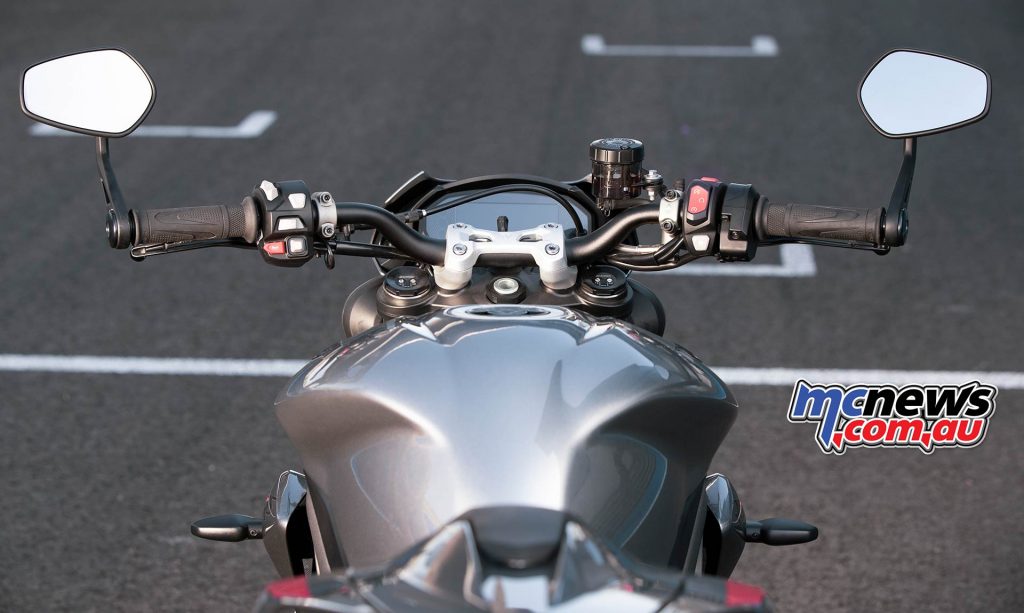
The standard bar end mirrors work well and look good. Heated grips and tyre pressure monitoring are optional extras and Triumph have quick-release tank and tail bags ready to go.
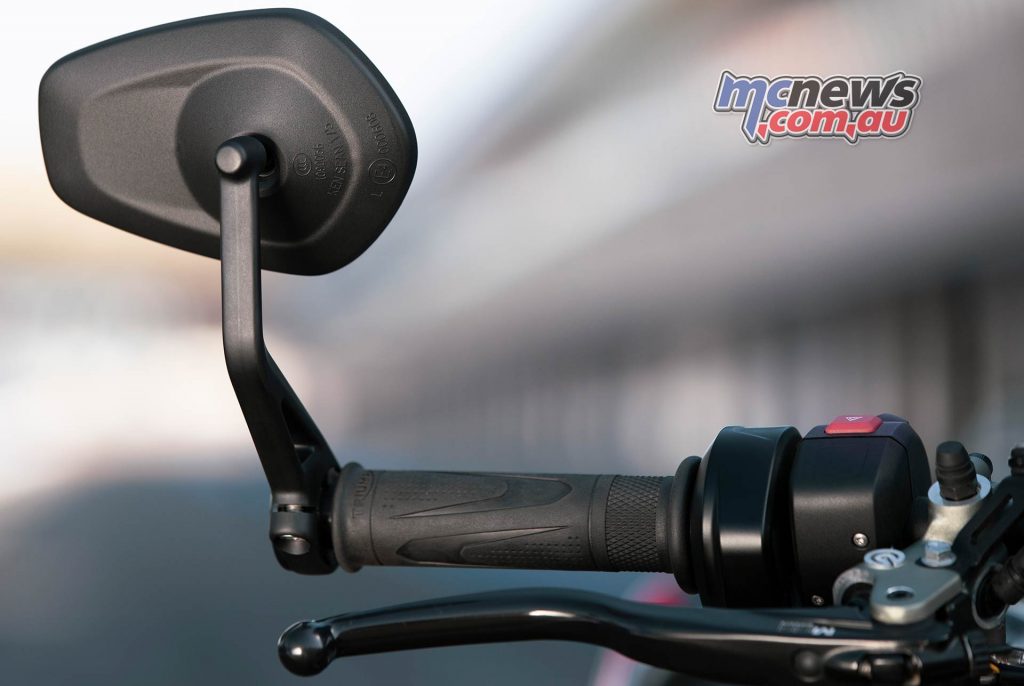
Triumph make no excuses for where they are pitching the Street Triple RS in the market-place and the premium level of kit utilised throughout the machine certainly justify its $18,050 +ORC price point. However, when there are many larger capacity and more powerful offerings already on offer it might be somewhat of a hard sell in what is a currently difficult market. Riders that place prime importance on the light is right mantra, and have a clear desire for high spec’ suspension and braking components should certainly do themselves a favour and sample the Street Triple RS for themselves. In this upper mid-capacity segment it is a performance leader and the most premium offering.
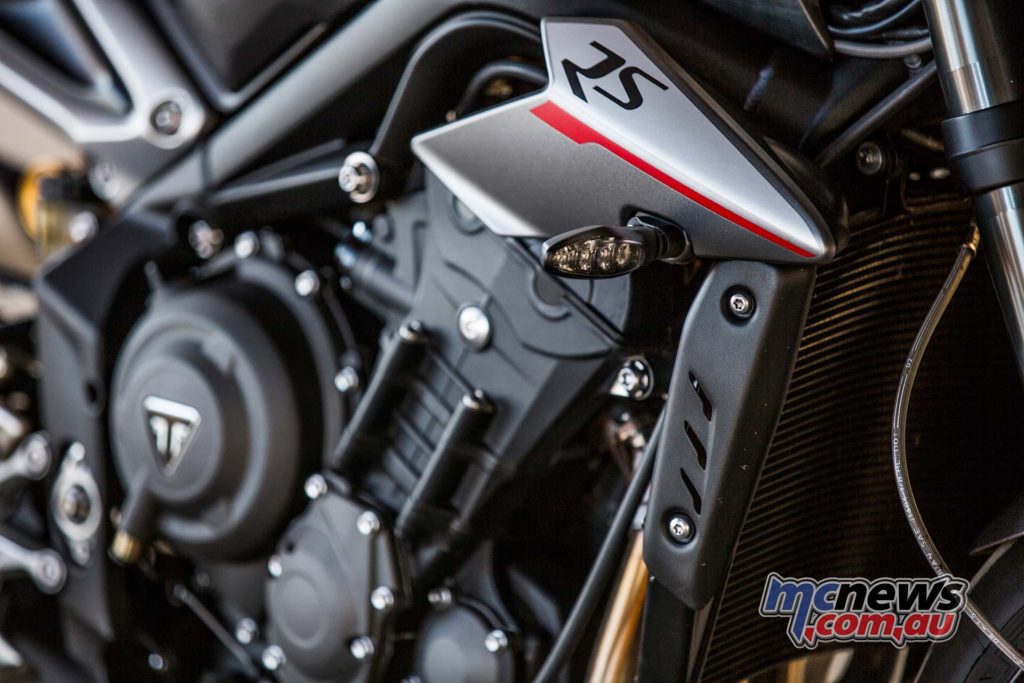
Arriving soon is also a LAMS legal variant dubbed the Street Triple S for new riders with an engine down-sized and detuned for those requirements along with lower spec’ suspension and braking components. The specifications for both bikes are selectable in the table below.
Specifications
| Street Triple RS | |
| Specifications | |
| Engine Type | Liquid-cooled, 12 valve, DOHC, in-line 3-cylinder |
| Capacity | 765 cc |
| Bore Stroke | 77.99 mm / 53.4 mm |
| Compression | 12.54:1 |
| Max Power | 123 PS / 121.36 BHP (90.5 kW) @ 11,750 rpm |
| Max Torque | 79 Nm @ 9350 rpm |
| System | Multipoint sequential electronic fuel injection with SAI. Electronic throttle control |
| Exhaust | Stainless steel 3 into 1 exhaust system low single sided stainless steel silencer |
| Final Drive | X ring chain |
| Clutch | Wet, multi-plate, slip-assisted |
| Gearbox | 6-speed with Triumph Shift Assist |
| Frame | Front – Aluminium beam twin spar Rear – 2 piece high pressure die cast |
| Swingarm | Twin-sided, cast aluminium alloy |
| Front Wheel | Cast aluminium alloy 5-spoke 17 x 3.5 in |
| Rear Wheel | Cast aluminium alloy 5-spoke 17 x 5.5 in |
| Front Tyre | 120/70 ZR17 |
| Rear Tyre | 180/55 ZR17 |
| Front Suspension | Showa 41 mm upside down big piston forks (BPF), Adjustable compression damping, rebound damping and preload adjustment. |
| Rear Suspension | Ohlins STX40 fully-adjustable piggyback reservoir RSU |
| Front Brake | Twin 310 mm floating discs, Brembo M50 4 – piston radial monobloc calipers |
| Rear Brake | Single 220 mm disc, Brembo single piston caliper, switchable ABS |
| Width Handlebars | 775 mm |
| Height Without Mirrors | 1085 mm |
| Seat Height | 825 mm |
| Wheelbase | 1405 mm |
| Rake | 23.9˚ |
| Trail | 100 mm |
| Dry Weight | 166 kg |
| Tank Capacity | 17.4 Litres |
| RRP | $18,050 + ORC |
| Street Triple S LAMS | |
| Specifications | |
| Engine Type | Liquid-cooled, 12 valve, DOHC, in-line 3-cylinder |
| Capacity | 660 cc |
| Bore Stroke | 76.0 x 48.5 mm |
| Compression | 12.13:1 |
| Max Power | 52 Hp @ 11,250 rpm |
| Max Torque | 61Nm @ 6,000 rpm |
| System | Multipoint sequential electronic fuel injection with SAI. Electronic throttle control |
| Exhaust | Stainless steel 3 into 1 exhaust system low single sided stainless steel silencer |
| Final Drive | X ring chain |
| Clutch | Wet, multi-plate |
| Gearbox | 6-speed |
| Frame | Front – Aluminium beam twin spar. Rear – 2 piece high pressure die cast |
| Swingarm | Twin-sided, cast aluminium alloy |
| Front Wheel | Cast aluminium alloy 5-spoke 17 x 3.5 in |
| Rear Wheel | Cast aluminium alloy 5-spoke 17 x 5.5 in |
| Front Tyre | 120/70 ZR17 |
| Rear Tyre | 180/55 ZR17 |
| Front Suspension | Showa 41 mm upside down forks |
| Rear Suspension | Showa piggyback reservoir monoshock, adjustable preload |
| Front Brake | Twin 310 mm floating discs, Nissin 2-piston sliding calipers, switchable ABS |
| Rear Brake | Single 220 mm disc, Brembo single piston caliper, switchable ABS |
| Handlebar Width | 765 mm |
| Height Without Mirrors | 1060 mm |
| Seat Height | 810 mm |
| Wheelbase | 141 0mm |
| Rake | 24.8° |
| Trail | 104.3 mm |
| Dry Weight | 168 Kg |
| Tank Capacity | 17.4 Litres |
- Street Triple RS
Street Triple RS Specifications Engine Type Liquid-cooled, 12 valve, DOHC, in-line 3-cylinder Capacity 765 cc Bore Stroke 77.99 mm / 53.4 mm Compression 12.54:1 Max Power 123 PS / 121.36 BHP (90.5 kW) @ 11,750 rpm Max Torque 79 Nm @ 9350 rpm System Multipoint sequential electronic fuel injection with SAI. Electronic throttle control Exhaust Stainless steel 3 into 1 exhaust system low single sided stainless steel silencer Final Drive X ring chain Clutch Wet, multi-plate, slip-assisted Gearbox 6-speed with Triumph Shift Assist Frame Front – Aluminium beam twin spar Rear – 2 piece high pressure die cast Swingarm Twin-sided, cast aluminium alloy Front Wheel Cast aluminium alloy 5-spoke 17 x 3.5 in Rear Wheel Cast aluminium alloy 5-spoke 17 x 5.5 in Front Tyre 120/70 ZR17 Rear Tyre 180/55 ZR17 Front Suspension Showa 41 mm upside down big piston forks (BPF), Adjustable compression damping, rebound damping and preload adjustment. Rear Suspension Ohlins STX40 fully-adjustable piggyback reservoir RSU Front Brake Twin 310 mm floating discs, Brembo M50 4 – piston radial monobloc calipers Rear Brake Single 220 mm disc, Brembo single piston caliper, switchable ABS Width Handlebars 775 mm Height Without Mirrors 1085 mm Seat Height 825 mm Wheelbase 1405 mm Rake 23.9˚ Trail 100 mm Dry Weight 166 kg Tank Capacity 17.4 Litres RRP $18,050 + ORC - Street Triple S LAMS
Street Triple S LAMS Specifications Engine Type Liquid-cooled, 12 valve, DOHC, in-line 3-cylinder Capacity 660 cc Bore Stroke 76.0 x 48.5 mm Compression 12.13:1 Max Power 52 Hp @ 11,250 rpm Max Torque 61Nm @ 6,000 rpm System Multipoint sequential electronic fuel injection with SAI. Electronic throttle control Exhaust Stainless steel 3 into 1 exhaust system low single sided stainless steel silencer Final Drive X ring chain Clutch Wet, multi-plate Gearbox 6-speed Frame Front – Aluminium beam twin spar. Rear – 2 piece high pressure die cast Swingarm Twin-sided, cast aluminium alloy Front Wheel Cast aluminium alloy 5-spoke 17 x 3.5 in Rear Wheel Cast aluminium alloy 5-spoke 17 x 5.5 in Front Tyre 120/70 ZR17 Rear Tyre 180/55 ZR17 Front Suspension Showa 41 mm upside down forks Rear Suspension Showa piggyback reservoir monoshock, adjustable preload Front Brake Twin 310 mm floating discs, Nissin 2-piston sliding calipers, switchable ABS Rear Brake Single 220 mm disc, Brembo single piston caliper, switchable ABS Handlebar Width 765 mm Height Without Mirrors 1060 mm Seat Height 810 mm Wheelbase 141 0mm Rake 24.8° Trail 104.3 mm Dry Weight 168 Kg Tank Capacity 17.4 Litres























